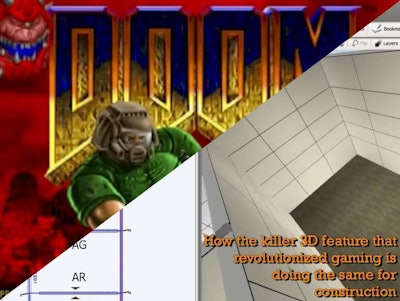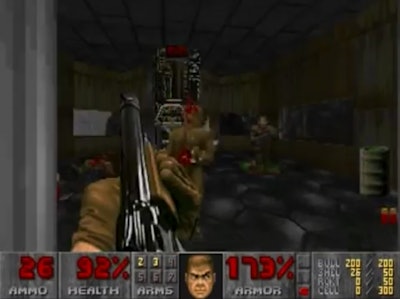
More than 20 years after its release, it’s easy to see how “Doom” was a preview of the future of video games. Just about every top-selling modern video game, be it the “Call of Duty” series or the slightly more-cinematic “The Last of Us,” involve gunplay of some sort and exploring complex 3D environments—seemingly simple constructs now, but ones that “Doom” brought to life in a meaningful way before any other game. The game has quite the legacy, landing on just about every “top video games of all-time” list you can think of.
A few years after its release, Barrie Loberg, then creating 3D fly-throughs for control room contractor Evans Consoles, would see “Doom” for the first time. The game had a major impact on him, as it did just about anyone who spent time with it upon its release.
“ICE does all the engineering. It won’t let us create something that’s not possible for us to manufacture.”
It’s hard to forget that first experience with “Doom” and the feeling of moving through a game from the character’s perspective for the first time. The stark, metal environment of an outer space military base. A hand grasping a gun floating in the middle of the frame as the camera hovers through hallways, stopping only to blast monstrous aliens into a million bloody pieces.
“Doom” is important because it changed the way a lot of people thought about video games. It was among the first steps toward video games truly pulling us into lifelike environments. For Loberg, the game was more impactful than it was for most, leading him to jumpstart the creation of a highly-adaptable piece of construction software that is making modular construction much more efficient.
The software is called ICE and it’s at the heart of Calgary, Alberta, Canada-based interior construction firm DIRTT (which stands for Doing It Right This Time). I recently spoke with Loberg and DIRTT president Scott Jenkins about ICE and the two men covered everything from the genesis of the software, to how the company is using it today in its modular construction business and their big plans moving forward.
See ICE in action:
The Perfect Storm
Jenkins mentioned that some media coverage of his company has suggested that the software engineers at DIRTT actually took the classic “Doom” game engine that iD Software used to bring the game to life back in 1992 and reengineered it for construction. Instead, Loberg said, the company only used the game’s engine as inspiration.
Loberg says he first saw the game in the mid-1990s while working at Evans Consoles, a company that designs, manufactures and installs control rooms for companies and government agencies. “It was early in my career and I was creating 3D fly-throughs for business presentations,” Loberg recalled. “At the time, the way you had to do it was linking 50 computers together and rendering one frame at a time. It took about a week to render a 30 second video.”
During a lunch break he overheard a few co-workers excitedly discussing a new computer game. And when he saw them play, he knew the technology could be a game changer… in the business world. While controversy played out in the media over the game’s gunslinging and gory gameplay, Loberg looked right past it to the underlying technical achievement and all of the possibilities it entailed. Seeing “Doom” allow players to move through a changing 3D space, with doors that moved aside and platforms that rose up out of the floor, caused a light bulb to go off in Loberg’s head. “I couldn’t believe this game was letting them run through a 3D environment without waiting,” Loberg says. “It didn’t look real necessarily but it was very compelling because it was in real time and you could immediately understand your surroundings.”
 Doom, released in 1994, pioneered the explosion of 3D first-person shooter video games like the “Call of Duty” series.
Doom, released in 1994, pioneered the explosion of 3D first-person shooter video games like the “Call of Duty” series.Loberg wanted to take the same technology that made a game like “Doom,” possible, and use it to allow designers at Evans and their clients to virtually explore a room or larger space the company was creating for them. This would have given the company a tremendous advantage since rendering software at the time was static.
When Loberg went to the leadership at Evans with the idea, they simply weren’t interested. But he didn’t drop the idea and a shakeup at Evans would soon propel it forward.
Jenkins calls it an “upheaval” that led to “the perfect storm.” Mogens Smed, who came from a construction background, took the helm at Evans as CEO, Jenkins said. And at the time, industrial designer Geoff Gosling was the compnay’s vice president of product development.
“As a side hobby, Gosling was noodling with a wall system for residential as well as some ideas for interior construction independent of his work for Evans,” Jenkins said. “It took Barrie almost a year to wear Mogens down on the idea on using the core engine of the video games. But eventually, that combined with Geoff’s ideas on interior construction and Mogens’ ideas on how to build distribution and sales.”
“Mogens saw better than I did how much it would impact the business,” Loberg said. In February 2004, Loberg, Smed and Gosling left Evans and started DIRTT.
Welding Ice
Since there could be no DIRTT without the rendering software Loberg was dreaming of, the company’s first work was building the software that would become ICE. The company hired a group of talented young programmers early on and eventually hired some away from the video game industry.
Loberg explained that one of his goals in developing ICE was to power DIRTT’s process from front end to back end—from the 3D fly-through to what the company’s manufacturing facility uses to assemble those spaces—with data rather than 3D drawings created in AutoCAD.
“I was interested in driving engineering directly from data and not drawings. In other programs the model is what drives the manufacturing and that burdens the model and makes it cumbersome,” he says. “We welded them together. The data that drives the business is also what drives the 3D model.”
However, Loberg said DIRTT realized that in the construction industry people would still need to be able to see AutoCAD drawings of the proposed space. And for that reason, the software still needed to be capable of generating them. The problem was, AutoCAD didn’t work with Java, the programming language Loberg wanted to build the software from.
Fortunately, he got a bit of help.
The creator of Java, James Gosling, is the brother Geoff, one of the founding members of the company. Java is one of the most popular programming languages because it was designed to allow developers to write a program once and run it on any computing platform. And as one of the founding board members, James Gosling kept an eye on the development of ICE and wondered why Loberg had chosen not to use Java to power it. “James told me to give him a call and he challenged me and my assumptions on not doing it before. He challenged me to convince him why it’s not possible and we actually came up with a way to make it work,” Loberg recalled. “Having James as a counsel was very helpful and we actually did link it to AutoCAD and it ended up being faster than it would have been otherwise.”
Smooth as ICE
 Within ICE sweeping changes can be made to spaces with just a few clicks. As walls are rendered in 3D, a parts list is created and a budget for the project is updated.
Within ICE sweeping changes can be made to spaces with just a few clicks. As walls are rendered in 3D, a parts list is created and a budget for the project is updated.Today, ICE is the “foundation of everything we do,” Jenkins said. He explained that most of the company’s business comes from recreating interior spaces for its clients by replacing drywall with prefabricated walls manufactured with electrical and other features built in.
Beyond giving clients a fly-through of the space they have ordered, Jenkins said ICE also links the project’s CAD drawings live and makes them available for on-the-fly changes. The software also updates pricing in real time when any changes are made. “If you change a door, it will take two seconds to give you a pricing update rather than a week later,” he said.
The other advantage to ICE, Jenkins said, is that it “understands a user’s design intent,” and eliminates the need for a user to have a serious engineering background.
“ICE does all the engineering. It won’t let us create something that’s not possible for us to manufacture,” Jenkins said. “If somebody is designing an oil refinery and they’re still drawing in CAD they need to be a petroleum engineer. ICE is already preprogrammed to handle what you throw at it. And it’s all linked together and live. In the past, while we used to do all of these soft drawings and elevations and everything else the building inspector or designer or architect would want to look at, all of these different versions of the project accumulated. ICE eleminates all of that.”
“AutoCAD and Revit may do one or two of these steps because they’re getting better in their visualizations. But they don’t understand a user’s design intent,” he argues.
So how does this whole process actually play out with a given client? Jenkins said it typically starts with DIRTT designers uploading a CAD file to the software to lay a foundation for the design. He said many clients provide a layout of their existing space but the DIRTT team can generate one from scratch if necessary.
Christine Michels works in DIRTT’s Houston office as a sales representative and is involved with clients in projects early on. “ICE makes my job easy because it eliminates all the questions I might have,” she said. “I don’t rely on anyone else in order to give someone a budget or a rendering or some other visual tool.”
 Thanks to ICE, at DIRTT everything is custom manufactured. Most spaces ship in two to three weeks and can be assembled at the site in about two weeks since they snap together like Legos.
Thanks to ICE, at DIRTT everything is custom manufactured. Most spaces ship in two to three weeks and can be assembled at the site in about two weeks since they snap together like Legos.“I come from an AutoCAD world and a Revit world and ICE was just very simple from the start. It forces you to step back and figure out what kind of wall you want to build and just design it. I’m never having to learn about a specific practice area because I know ICE is going to be able to draw what I need to draw.”
Even after years of using the software, Michels said she’s still impressed with the fact that as she draws a line in ICE, the wall is automatically being rendered in 3D while a parts list is created and a budget for the project is updated. “I can switch between the data, the 3D rendering and even over to the AutoCAD or Revit drawings.”
Michels explained that as soon as a wall is created, it can be easily modified, even at the last minute without having to re-draw anything. “We recently had a client with a last minute change where they wanted to change all the doors in the offices to veneer we were able to go in and make that change and update the pricing with just a couple of clicks,” she said.
Once the design is complete, ICE generates the manufacturing file which is signed off on by the client. DIRTT project managers then review the file once more before it is sent along for custom manufacturing. “That’s the secret sauce,” Jenkins said. “Custom is standard at DIRTT, not more expensive. We are cost-compelling because of our use of ICE throughout the project.”
He said most projects ship from the manufacturing facility in two or three weeks, but the process can be accelerated even further on projects that are top priority. Jenkins said the company recently completed an office redesign of the Levi’s San Francisco headquarters in only 11 days.
“The big benefit for DIRTT and our clients is we delver that custom solution three to four times faster than traditional construction with significantly fewer mistakes,” Jenkins said. “We compress all of the steps in the process into one core data set. Then we deliver a solution that snaps together like LEGO.”
And should a client return to DIRTT for yet another redesign of a particular space, the ICE Cycle portion of the software can compare the client’s new plan to their current design and actually identify materials in the current design that can be recycled in manufacturing the new design.
“Each file ICE creates has every piece of the design—every screw—barcoded. Typically you throw away those (currently in place) materials, but because ICE design files are reconfigurable, we can reuse up to 73 percent of those old materials in a new project.”
Looking Forward
The majority of the company’s clients are corporate entities. However, as of late, the company has also seen a lot of growth in healthcare.
“In North America, I believe that we’re the only prefab manufacturer that can build out a whole hospital room,” Jenkins said. DIRTT has done work for several hospitals in the U.S. and Canada and has even done nine projects in Saudi Arabian medical cities.
DIRTT has also begun working with contractors that want to use ICE to speed up their own process. DIRTT programmers sit down with the company, forming a joint development team and works with the company to use the software for that company’s application.
The software has proven to be such a game-changer for prefab construction and manufacturing, that DIRTT has spun ICE off as external subsidiary of the company. “We now have external customers of ICE and it has excellent potential as a standalone,” Jenkins said. “We have some significant companies in other industries who have come to us and are now generating extra revenue for us. We’re looking at how to turbocharge that.”











